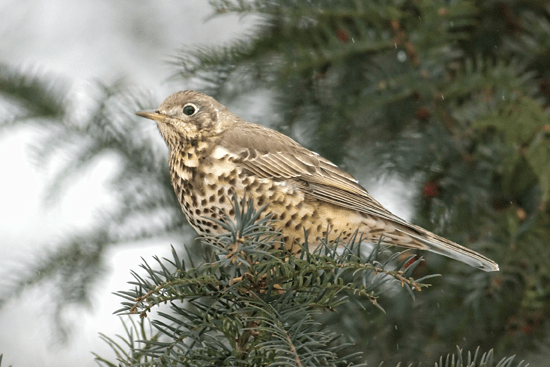Passereau de taille supérieure (20 à 30%) à celle de la grive musicienne (Turdus philomelos) mais plus pâle que cette dernière (à gauche : grive draine, à droite grive musicienne).
Grive Draine
Adulte
Grive Draine
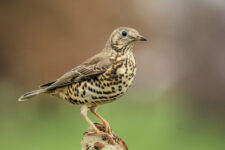
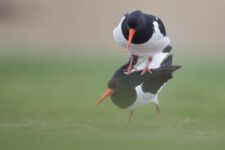
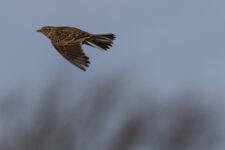
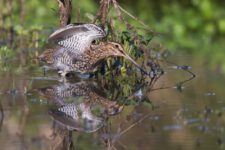
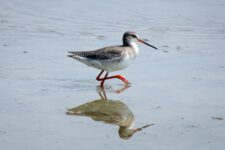
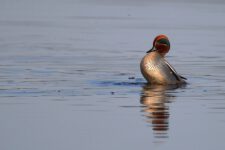
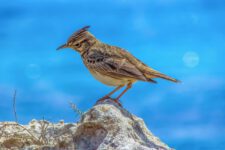
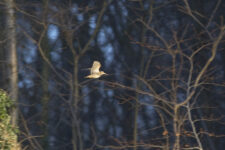
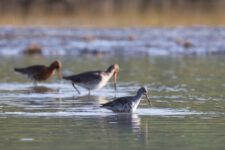
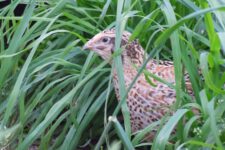
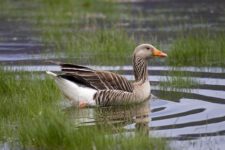
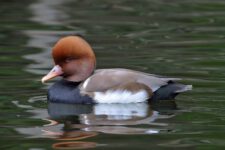
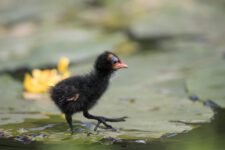
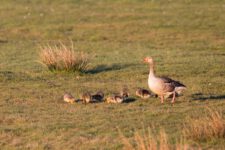
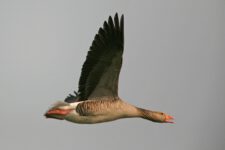
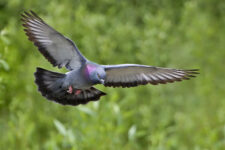
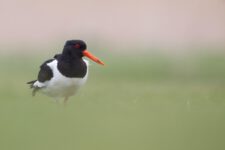
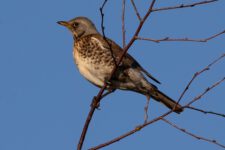
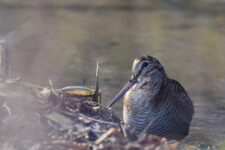
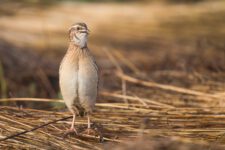
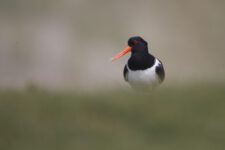
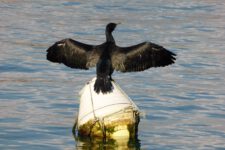
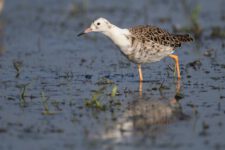
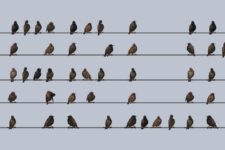
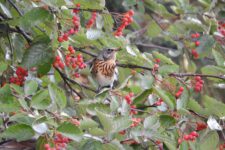
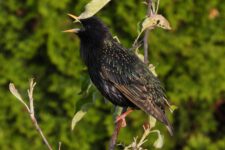
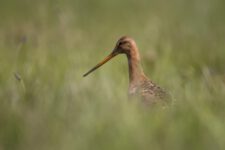
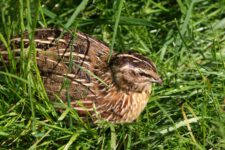
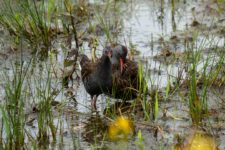
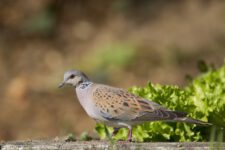
Description et Identification
Passereau de taille supérieure (20 à 30%) à celle de la grive musicienne (Turdus philomelos) mais plus pâle que cette dernière (à gauche : grive draine, à droite grive musicienne). Les bords externes des plumes de la queue (rectrices) et l’extrémité des couvertures sont blanches chez la grive draine et de couleur marron chez la grive musicienne. La grive draine est la plus grosse espèce des Turdidés chassables et sans doute la plus méfiante car se déplaçant en petits groupes familiaux bien structurés (guetteurs perchés à la cime des arbres pendant que le reste du groupe s’alimente). Ce comportement est similaire à celui de la grive litorne et de la grive mauvis qui se déplacent en groupes plus nombreux et moins organisés.
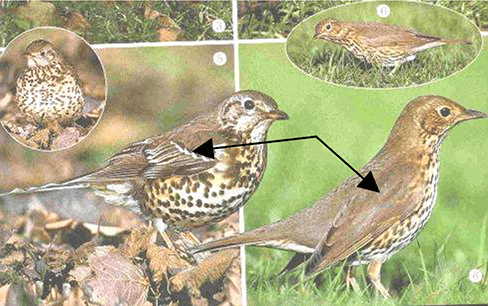
Sa longueur moyenne est de 23 cm et son envergure varie de 33 à 36 cm. Les pattes sont jaunâtres et les tâches plus grosses que chez la grive musicienne. La queue est plus longue proportionnellement au corps que chez les autres grives Les deux sexes sont semblables. Les mâles pèsent en moyenne 110 g (96-134) et les femelles 120g (106-140). On distingue trois races : T.v.viscivorus ; T.v.deichleri et T.v.bonapartei.
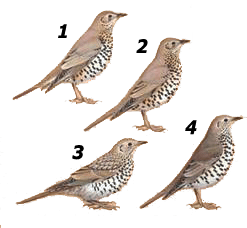
1 : T.v.viscivorus : adulte
2 : T.v.viscivorus: 1ère année
3 : T.v.deichleri : juvénile
4 : T.v.deichleri : adulte
La race bonapartei est un peu grande (30 cm) avec des ailes plus longues et plus pâles sur le dessus. La race deichleri a un plumage similaire à celui de bonapartei mais sa taille est comparable à celle de viscivorus
La voix : le cri habituel est celui d’une crécelle sèche (trrrré) émis souvent en vol (alarme). Elle émet aussi un teuc teuc teuc rapide. Le chant au printemps est très pur et ressemble à celui du merle noir (Turdus merula) , en moins mélodieux et moins varié.
Répartition Géographique
L’espèce est commune dans toute l’aire de répartition mais plus rare dans les parties orientales de la Russie, des Balkans et de l’Allemagne. Son aire s’est étendue depuis le 19è siècle tant en Grande Bretagne, comme aux Pays bas ou en Autriche.
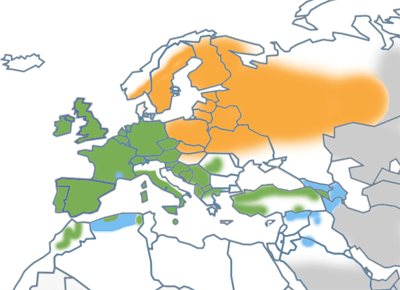
 : Espèce présente toute l’année
: Espèce présente toute l’année
 : Présente en été
: Présente en été
 : Hôte hivernal
: Hôte hivernal
Répartition géographique des «sous-espèces ou races» : la race type (T.v.viscivorus) est présente de la Grande Bretagne au sud-est de la Suède et de la Norvège , en Finlande , en Russie occidentale , en Espagne , au Portugal , dans les Apennins , en Sicile , plus à l’est en Turquie notamment à l’ouest et au sud ,en Grèce , au nord de l’Irak et au nord-ouest de l’Iran. La race T.v.deichleri est présente au nord du Maroc dans les Monts de l’Atlas, partiellement au nord de l’Algérie, au nord-ouest de la Tunisie, en Corse et en Sardaigne. La troisième race T.v.bonapartei est présente en Sibérie, au sud-ouest du lac Baïkal, à l’est jusqu’en Afghanistan, au Pakistan et dans l’Himalaya où elle peut nicher entre 1800 et 3900 m, elle est présente au Népal, au sud du Kazakhstan, au sud du Turkménistan et notamment au nord de l’Iran.
Détermination de l’âge et chronologie de la mue
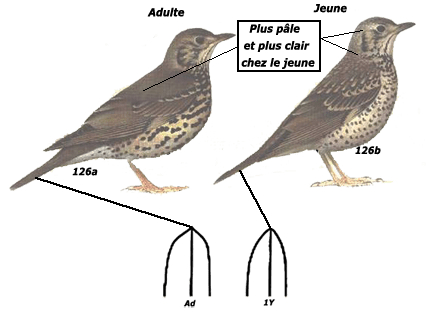
Rectrices centrales (plumes de la queue)
Habitat et Alimentation
L’habitat de reproduction de la grive draine n’est pas exclusivement forestier mais elle préfère plutôt les clairières, les zones ouvertes de bordures de bois et les grandes haies. Elle colonise les parcs des villes. Au sud et à l’est de son aire de répartition, elle vit en moyenne montagne dans des peuplements de conifères, de genévriers, ou de forêts mixtes. Elle utilise quelquefois les hauts plateaux dépourvus d’arbres avec des prairies. En Afrique du Nord elle vit au dessus de 600 m d’altitude et occasionnellement jusqu’à 1700 m. En zone méditerranéenne elle se trouve plutôt sur les collines et moyennes montagnes qu’en plaine mais là aussi elle évite les massifs forestiers trop denses. Notons enfin qu’elle évite de nos jours l’extrême frange littorale méditerranéenne. En hiver, elle utilise préférentiellement les prairies bordées de grandes haies et des espaces ouverts de moyenne altitude.
La grive draine se nourrit d’une grande variété d’invertébrés et de fruits sauvages notamment de gui. On l’appelle d’ailleurs la » grive du gui » (viscivorus = mangeur de gui) dont elle assure en partie la dissémination. Contrairement à la grive musicienne, on n’a jamais observé une grive draine utiliser une pierre (enclume) pour briser des coquilles d’escargot. Parmi les invertébrés consommés on peut citer les principaux ordres d’insectes : Orthoptères (grillons, sauterelles) ; les adultes et les larves de Lépidoptères (Papillons,..) ; les adultes et les larves d’Hyménoptères (Fourmis) ; des Araignées ; des Gastéropodes (Escargots, limaces, ..) et des Lombrics. La nourriture végétale se compose de baies mais aussi de graines de Genévriers, Gui, Houx, Sorbiers, Ronces, Vignes etc.. En proportion, l’analyse de 52 estomacs en Angleterre a montré la présence de 55% d’invertébrés et de 45% de végétaux. Chez les jeunes au nid, le régime alimentaire est composé exclusivement d’invertébrés apportés par les parents : larves de diptères ; larves de coléoptères ; lombrics ; limaces et larves de lépidoptères.
Reproduction
Le début de la reproduction est plus précoce en Angleterre et débute en fin février, au Nord de l’Afrique elle commence en fin mars mais en fin avril en Finlande. En France, un suivi réalisé pendant 20 ans a permis de situer la ponte du premier œuf entre le 20 mars et le 5 avril dans le centre de la France. Les nids sont situés en général dans des grands arbres à une hauteur moyenne de 5 à 10 m au dessus du sol. Certains cas de nidification au sol ont été observés. Le nid est tapissé de brindilles et de feuilles, a un diamètre moyen externe de 18 cm et interne de 10 cm. Les œufs ont une coloration variable (voir planche), mesurent 30 mm x 22 mm en moyenne et pèsent 7 à 8 g.

Les pontes les plus fréquentes sont de 4 œufs (61 à 62% selon les études). La grive draine réalise fréquemment deux couvées et occasionnellement trois dans une saison de reproduction. L’incubation dure 12 à 15 jours, assurée par la femelle et occasionnellement par le mâle. Les jeunes sont nourris au nid par les deux parents. Il est fréquent que le mâle continue seul le nourrissage des jeunes pendant que la femelle incube une deuxième ponte. Les jeunes restent deux semaines au nid et deviennent indépendants 2 semaines après l’envol. Le succès de la reproduction varie d’une année à l’autre et selon les contraintes environnementales. Sur un échantillon de 435 nids suivis en Angleterre, 40% ont produit un jeune à l’envol. En France, sur 328 nids dont les poussins ont été bagués, une production de 3.4 jeunes par nichée réussie a été constatée. La reproduction terminée les grives draines vivent en petits groupes familiaux.
Populations
Une synthèse européenne récente (2004) situe les effectifs de couples nicheurs entre 3 et 7.4 millions ce qui représente un accroissement des connaissances de 60 à 80% d’effectifs de plus par rapport à la synthèse de 1994 du même organisme. Désormais 41 pays sont concernés et l’Europe représente plus de 50% de son aire de reproduction. Stable de 1970 à 1990 et de 1990 à 2000 avec un accroissement en Allemagne et une stabilité en Russie, la grive draine est classée » sécurisée » en Europe. Son état de conservation est considéré comme favorable.
Les 5 premiers pays accueillant les effectifs de couples nicheurs les plus importants sont : la Russie (1 à 3 millions) ; l’Espagne (0.33 à 0.79 million) ; l’Allemagne (0.3 à 0.55 million) ; le Royaume Uni (0.23 million) et la France (0.1 à 0.5 million). L’Italie accueille entre 0.05 et 0.1 million de couples et l’on peut se demander les raisons du statut d’espèce protégée de la grive draine dans ce pays alors que l’état de conservation de l’espèce est excellent.
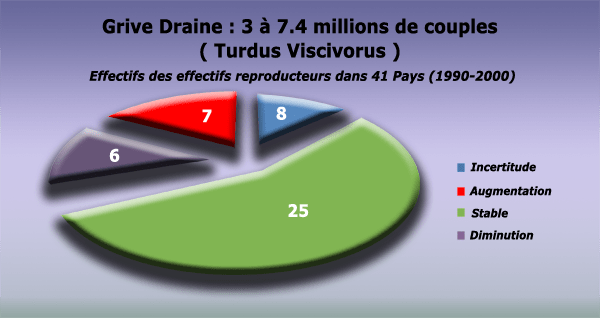
Parmi les 41 pays ayant fourni des informations en 2004 sur le statut de l’espèce (graphe ci-dessus), 30 pays (73%) considèrent les effectifs comme stables ou en augmentation, 6 en diminution et 5 ne se prononcent pas.
A l’échelle de l’ensemble de cette vaste zone couverte par 41 pays (plus de 5 millions de Km²) et en admettant une production moyenne de 2 jeunes par couple ayant survécu jusqu’au départ en migration d’automne, on peut estimer les effectifs de grives draines entre 12 et 29 millions. Le rapprochement de ces deux estimations d’effectifs situerait la densité après la reproduction entre 2.4 et 5.8 oiseaux au Km² (par 100 ha). Cet indice moyen doit être pondéré
par des effets de concentration d’effectifs en hiver sur des zones favorables tant du point de vue alimentaire que climatique.
En France les deux réseaux de suivi d’oiseaux nicheurs (ONCFS/FNC et STOC/MNHN) s’accordent pour montrer une progression des effectifs nicheurs de 2001 à 2003 et une stabilité ensuite. Les densités moyennes connues au printemps sur certains sites de l’Allier en France et suivis régulièrement par des méthodes adaptées varient de 0.3 à 1.4 couples pour 10 ha.
Taux de mortalité
La mortalité annuelle des adultes est de 48% et celle des jeunes, de l’envol à leur première année, est de 68%. L’âge du plus vieil oiseau bagué connu est de 11 ans et 4 mois.
Mouvements dans le Paléarctique Occidental
En moyenne on peut considérer les populations nordiques et orientales comme migratrices et celles plus au sud et à l’ouest comme sédentaires ou à faible dispersion. Ainsi la race deichleri est plutôt sédentaire (Afrique du nord, Corse, Sardaigne). Des oiseaux originaires de Scandinavie et d’Europe centrale hivernent de la Belgique jusqu’au nord de l’Espagne, en incluant le sud et l’ouest de la France. Contrairement à ce qui est observé chez d’autres espèces de Turdidés (grive mauvis et grive litorne) de longs déplacements n’ont pu être mis en relation avec des hivers rigoureux. Les oiseaux Britanniques sont plutôt sédentaires avec des déplacements de quelques dizaines de kilomètres. Lors de la migration d’automne (septembre-octobre) les oiseaux nés en Grande Bretagne se déplacent vers le sud-ouest de la France. Les reprises plus au sud d’oiseaux bagués en Finlande et en Suède tendent à montrer un axe de migration orienté vers le sud-est. La » race » orientale bonapartei qui réside en Himalaya se déplace en hiver vers des latitudes plus méridionales en Russie orientale, vers le Kazakhstan et le Tadzhikistan.
La grive draine est connue pour se déplacer le jour comme la grive litorne. Sur plus de 10 000 heures d’enregistrements réalisés dans l’arc méditerranéen par l’IMPCF aucun cri de grive draine n’a été enregistré la nuit. Des comptages diurnes standardisés hebdomadaires et décadaires réalisés pendant plus de 10 ans sur l’arc méditerranéen français (IMPCF /FDC) montrent que l’hivernage de la grive draine est moins fluctuant d’une année à l’autre (variations inférieures à un facteur 2) de ce que ne l’est celui de la grive mauvis ou de la grive litorne (facteur de 1 à 10 selon les années pour ces deux espèces). Les premiers passages de grives draine ont lieu en première décade d’octobre au sud de la France. La migration postnuptiale débute plus tôt au Nord (Italie – Lombardie : fin septembre) et se poursuit jusqu’en novembre (Péninsule Ibérique, Afrique du Nord).
La migration de retour débute en février au nord de l’aire d’hivernage, en fin février en zone méditerranéenne et en mars pour les oiseaux ayant hiverné en Afrique du nord. Les » pics » successifs de migration de retour ont lieu en mars et se prolongent jusqu’en avril ainsi qu’ont pu le montrer les suivis par comptages standardisés dans le sud de la France. Ces résultats sont cohérents avec ceux relatifs aux dates d’arrivées sur les lieux de nidification qui se succèdent de mars (Europe centrale) à fin mai (Pays scandinaves) selon un gradient latitudinal.
Chasse-gestion des Populations et des Habitats
La grive draine est la moins chassée des grives malgré une tradition de chasse des Turdidés dans les Pays méditerranéens (Chypre, Espagne, France, Grèce, Malte, Portugal). Dans ces pays la chasse est pratiquée depuis l’antiquité selon des procédés traditionnels, avec ou sans appelant, mais aussi au fusil, devant soi ou à poste fixe. Dans le sud est de la France (5 départements) la capture de cette espèce à la glue est autorisée par dérogation à la directive 79/409 (article 9). Elle est classée en dernière position (1.9%) par ordre décroissant selon le % du tableau de chasse aux Turdidés dans deux départements (Var et Vaucluse) pour les années 2000.
En février 2007 le Conseil d’Etat a retenu les résultats scientifiques de l’IMPCF et des 16 Fédérations de Chasseurs adhérentes (toutes celles de l’arc méditerranéen sauf celle du Gard).
Ainsi par un jugement au fond, la Haute Cour a autorisé la chasse des Turdidés (merle noir et grives) jusqu’au 20 février dans 17 départements du sud alors que la chasse de ces espèces ailleurs en France ferme le 10 février. Pour cela, l’IMPCF a démontré que la migration de retour dans la zone méditerranéenne débute au cours de la troisième décade de février, résultats validés par l’Observatoire national de la faune sauvage et de ses habitats (ONFSH.2005). Cette différence avec le reste de la France est due à l’origine plus nordique des populations venant hiverner ou traversant la région méditerranéenne en automne et en hiver et donc rejoignant plus tardivement leurs zones de reproduction nordiques au début du printemps. Ces résultats sont confirmés par l’échelonnement des dates d’arrivées sur les lieux de nidification selon un gradient latitudinal.
Les prélèvements réalisés par la chasse à tir en Europe sont insuffisamment connus et mériteraient de faire l’objet d’une méthodologie commune (un projet FACE ARTEMIS est en cours). Par sondage aléatoire (SOFRES) , les prélèvements nationaux des quatre espèces de grives (musicienne, mauvis, litorne et draine) ont été estimés en France (ONCFS-UNFDC) en 1998/1999 à 4 537 960 (± 1.8%). Ce chiffre représente moins de 1% de la valeur médiane du des effectifs européens avant le départ en migration calculé en considérant la production moyenne de deux jeunes par couple,
Comme pour les autres Turdidés chassables, l’instauration d’un carnet de prélèvements (CPU -FNC ou recueil par chaque Fédération comme cela est réalisé dans les Hautes Alpes et les Alpes Maritimes en Région PACA) ou d’un suivi annuel par enquête comme établi en Italie et en Grèce, permettrait un suivi annuel. Les enquêtes nationales en France étaient réalisées tous les dix ans en moyenne ce qui interdisait toute comparaison pour un groupe d’espèces migratrices dont le niveau de migration et d’hivernage est largement tributaire des conditions météorologiques annuelles y compris pour cette espèce qui reste néanmoins la moins réactive des Turdidés chassables aux hivers rigoureux.
L’avenir de cette espèce repose aussi et surtout sur le maintien de la qualité de ses habitats, tant de reproduction que d’hivernage. La diversité des paysages, offrant alternance de milieux ouverts (prairies, landes, zones cultivées) et de boqueteaux, bosquets et grandes haies comportant de grands arbres est essentielle à son maintien. Les arbustes et les arbres à baies constituent une part importante des besoins trophiques de même que la faune invertébrée associée. On ne peut qu’encourager d’une part la reconstitution de haies pour la faune selon des principes écologiques nouveaux (volumes, strates, espèces végétales adaptées au climat et productrices de baies et ¦voir à ce sujet le document de synthèse IMPCF réalisé en 1995 grâce à un financement du Conseil Régional Languedoc Roussillon : programme Faune Flore Paysages). D’autre part le développement et l’encouragement financier (Région-Etat-Europe) de méthodes agricoles respectueuses de l’environnement sont aussi des éléments indispensables au maintien d’une faune invertébré variée dont l’espèce se nourrit. Enfin le maintien de paysages variés en mosaïque s’inscrivant dans les projets et actions de protection de la biodiversité » ordinaire » ne peut être à l’avenir que favorable à la grive draine.































